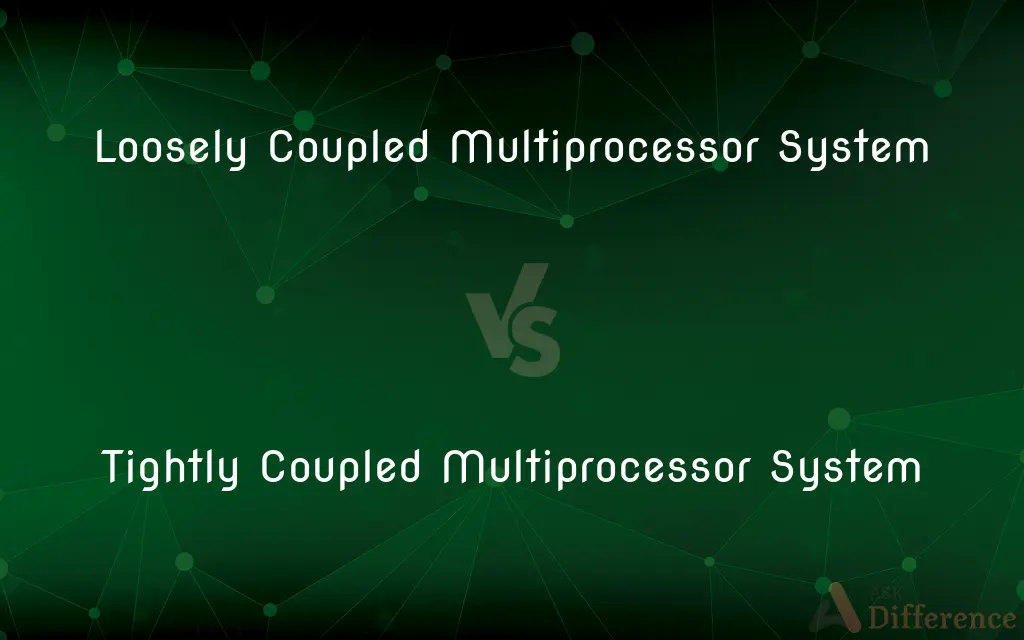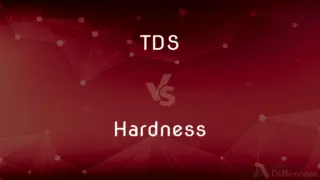Loosely Coupled Multiprocessor System vs. Tightly Coupled Multiprocessor System — What's the Difference?
By Tayyaba Rehman — Published on January 17, 2024
Loosely coupled systems have independent processors with their own memory, while tightly coupled systems share processors and memory.

Difference Between Loosely Coupled Multiprocessor System and Tightly Coupled Multiprocessor System
Table of Contents
ADVERTISEMENT
Key Differences
A Loosely Coupled Multiprocessor System consists of processors with their own memory and resources, operating independently. Tightly Coupled Multiprocessor Systems, on the other hand, have processors sharing a single, centralized memory, which allows for faster data exchange and process synchronization.
In Loosely Coupled Multiprocessor Systems, communication occurs through interprocessor connections using messages. Tightly Coupled Multiprocessor Systems facilitate communication via a shared memory, leading to a quicker and more direct data transfer between processors.
Scalability is a prominent feature of Loosely Coupled Multiprocessor Systems, allowing more processors to be added with minimal design changes. Tightly Coupled Multiprocessor Systems usually have a fixed number of processors, with scalability being more complex due to shared resources.
The failure of one processor in a Loosely Coupled Multiprocessor System often does not affect the others, ensuring high fault tolerance. In Tightly Coupled Multiprocessor Systems, however, a failure in the shared memory or interconnect can impact the entire system.
Loosely Coupled Multiprocessor Systems are typically used in distributed computing environments where tasks are independent. Tightly Coupled Multiprocessor Systems are often found in applications requiring intensive data processing and real-time computing.
ADVERTISEMENT
Comparison Chart
Memory Sharing
No shared memory
Shared memory across all processors
Processor Communication
Interprocessor messaging
Direct memory access
Scalability
Easily scalable
Scalability is complex
Fault Tolerance
High, independent failures
Low, shared resources
Typical Use Cases
Distributed computing
Intensive data processing
Compare with Definitions
Loosely Coupled Multiprocessor System
System where processors work independently.
We’re implementing a Loosely Coupled Multiprocessor System to distribute our computing load.
Tightly Coupled Multiprocessor System
System designed for real-time processing.
The flight control software relies on a Tightly Coupled Multiprocessor System.
Loosely Coupled Multiprocessor System
High fault tolerance due to independence.
The network's robustness is due to its Loosely Coupled Multiprocessor System design.
Tightly Coupled Multiprocessor System
Processors share a central memory resource.
Their Tightly Coupled Multiprocessor System facilitates rapid data processing.
Loosely Coupled Multiprocessor System
Independent processors with separate memories.
In a Loosely Coupled Multiprocessor System, one processor's crash doesn't halt the others.
Tightly Coupled Multiprocessor System
Less scalable due to interdependence.
Upgrading the Tightly Coupled Multiprocessor System requires extensive planning.
Loosely Coupled Multiprocessor System
Processes communicate via messages.
The Loosely Coupled Multiprocessor System ensures privacy through isolated processing.
Tightly Coupled Multiprocessor System
Direct memory access between processors.
Our Tightly Coupled Multiprocessor System allows for immediate data synchronization.
Loosely Coupled Multiprocessor System
A system scalable with minimal design changes.
Their new data center uses a Loosely Coupled Multiprocessor System for easier expansion.
Tightly Coupled Multiprocessor System
Low fault tolerance, shared resource risk.
A memory fault in the Tightly Coupled Multiprocessor System can cause widespread disruption.
Common Curiosities
How do processors in a Tightly Coupled Multiprocessor System communicate?
They communicate through shared memory for direct data access.
What happens if one processor fails in a Loosely Coupled System?
The system generally continues to function, as processors are independent.
Can I add more processors easily to a Loosely Coupled Multiprocessor System?
Yes, it is designed for easy scalability.
What is a key feature of a Loosely Coupled Multiprocessor System?
Its key feature is the independent operation of processors with their own memory.
What's a drawback of a Tightly Coupled System in case of failure?
A single point of failure can impact the entire system.
Is a Tightly Coupled Multiprocessor System good for real-time applications?
Yes, because of the fast data exchange through shared memory.
What's the typical use case for a Tightly Coupled Multiprocessor System?
They are used in applications that require intensive data processing.
Can a Loosely Coupled System operate if the network fails?
Individual processors can still function, but interprocessor communication is hindered.
Are Loosely Coupled Systems good for distributed tasks?
Yes, they excel in environments where tasks are independent of each other.
What type of memory access is used in Tightly Coupled Systems?
They use direct memory access, which is faster.
Are Loosely Coupled Systems fault-tolerant?
Yes, they have high fault tolerance due to the independence of their processors.
Can Tightly Coupled Systems be easily expanded?
No, their scalability is more complex due to shared resources.
Do Loosely Coupled Systems require a lot of interconnect hardware?
No, they often use network messaging, which requires less interconnect hardware.
What is a challenge in managing Tightly Coupled Systems?
Managing the shared memory and processor coordination is challenging.
Is specialized software needed to manage Tightly Coupled Systems?
Yes, because of the complex nature of resource sharing.
Share Your Discovery

Previous Comparison
Red Algae vs. Brown Algae
Next Comparison
TDS vs. HardnessAuthor Spotlight
Written by
Tayyaba RehmanTayyaba Rehman is a distinguished writer, currently serving as a primary contributor to askdifference.com. As a researcher in semantics and etymology, Tayyaba's passion for the complexity of languages and their distinctions has found a perfect home on the platform. Tayyaba delves into the intricacies of language, distinguishing between commonly confused words and phrases, thereby providing clarity for readers worldwide.











































